“Does my horse have reining potential?” I hear that question many times a year from customers who bring their horses to me for evaluation and possible training. Based on well over 30 years’ worth of experience, I’m able to tell some owners that yes, their horses do have enough potential to justify an investment in training for reining–but I have to tell others their horses really would be better suited to another line of work. Here, as a benefit to your own knowledge base, I’ll cover four key matters I consider when asked to make the initial assessment, and as training progresses.
First Matter: Pedigree
Let’s say you were to call me about a horse you’d like to place with me for training as a reiner. My first question’s going to be, “How’s your horse bred?” Reining talent comes from genetics, because it’s genetics
that produce the conformation traits that allow a horse to stop, spin, roll back, and change leads with ease. Genetics also are largely responsible for a horse’s innate degree of trainability. That’s not to say you get any guarantees, even with a solid reining pedigree, but it sure does up your chances.
If your prospect didn’t have parents that proved themselves capable of being reiners, his overall odds for success aren’t great. “He really stops great when he’s chasing dogs in the pasture” doesn’t count.
I won’t even look at a horse as a prospect for reining if he isn’t bred for the event–not because I’m a pedigree snob, but because I don’t think it’s fair to spend your money and my time on trying to force a square peg into a round hole. Chances are high that both you and I would be disappointed, and that your horse would be over-challenged, and frustrated.
Second Matter: Conformation
Assuming your horse is bred for reining, my next step would be to see him in person, to evaluate his conformation. Although some owners ask me to look at their prospects as yearlings, or even weanlings,
I don’t think you can see a lot until a horse is at least 2 years old. Horses simply change too much as they’re adding their growth to that point.
For eye-training examples of what I look for, compare Horse A and Horse B in the accompanying conformation shots.
Horse A, the palomino, has a head I like, with big, intelligent-looking eyes, good-sized nostrils, a relaxed set of ears, and a short mouth. He has a small, clean throatlatch for ease in flexing, and a neck that’s longer on top than on bottom, also good for flexing. The curvature over the top of his neck contributes more to his flexing ability. He has an adequately sloped shoulder that ties in high to his shoulders, and isn’t so bulky in his front-end musculature that it limits his ability to turn around. I like the short length of his back, because a long-backed horse has a hard time collecting himself well enough to change leads.
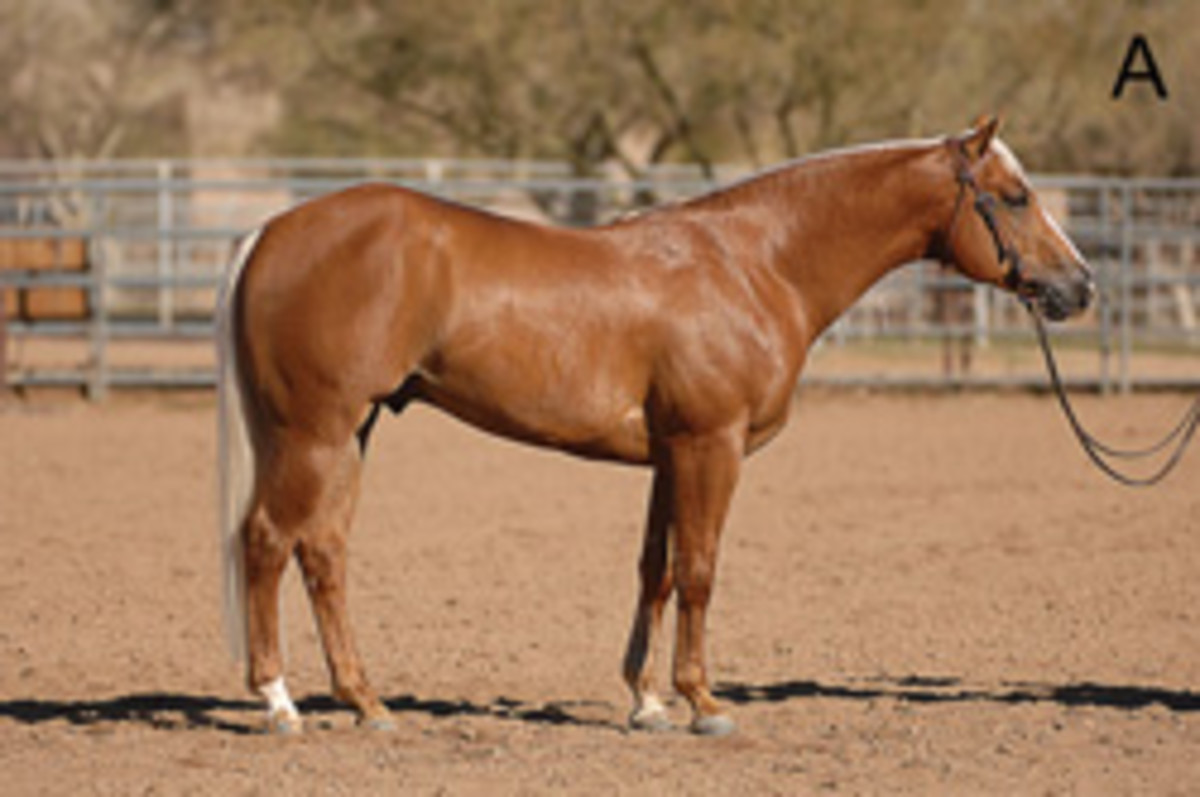
Horse A doesn’t have high flanks, which is good, because that trait tends to go along with weak stifles. Instead, he has meaty stifles, and meaty hocks as well–meaning he’s well-muscled in those areas for the
work that reining demands. I like the way this horse’s leg-bone columns align beneath his shoulders and hindquarters, because this trait should help him stay sound. He’s not bench- or calf-kneed, nor do his hocks sit too far back from, or in front of his hips. I left his saddle off so you could see the prominence of his withers, and his good depth of heartgirth. The fact that he’s a bit hip-high doesn’t bother me, as he’s barely
3 here, and still has some growing to do.
Horse B is conformed well enough for me to give him a try in training for reining. Nevertheless, he has some potential limitations. He lacks the degree of head refinement that Horse A has, particularly in his smaller eyes and longer mouth. His throatlatch is thicker, and his neck is noticeably shorter, both on
top and bottom. It’s straighter on top than Horse A’s neck, too, and ties in thickly to a steeper shoulder. His whole front end is heavily built, which makes him less nimble in maneuvers than Horse A is capable of being.
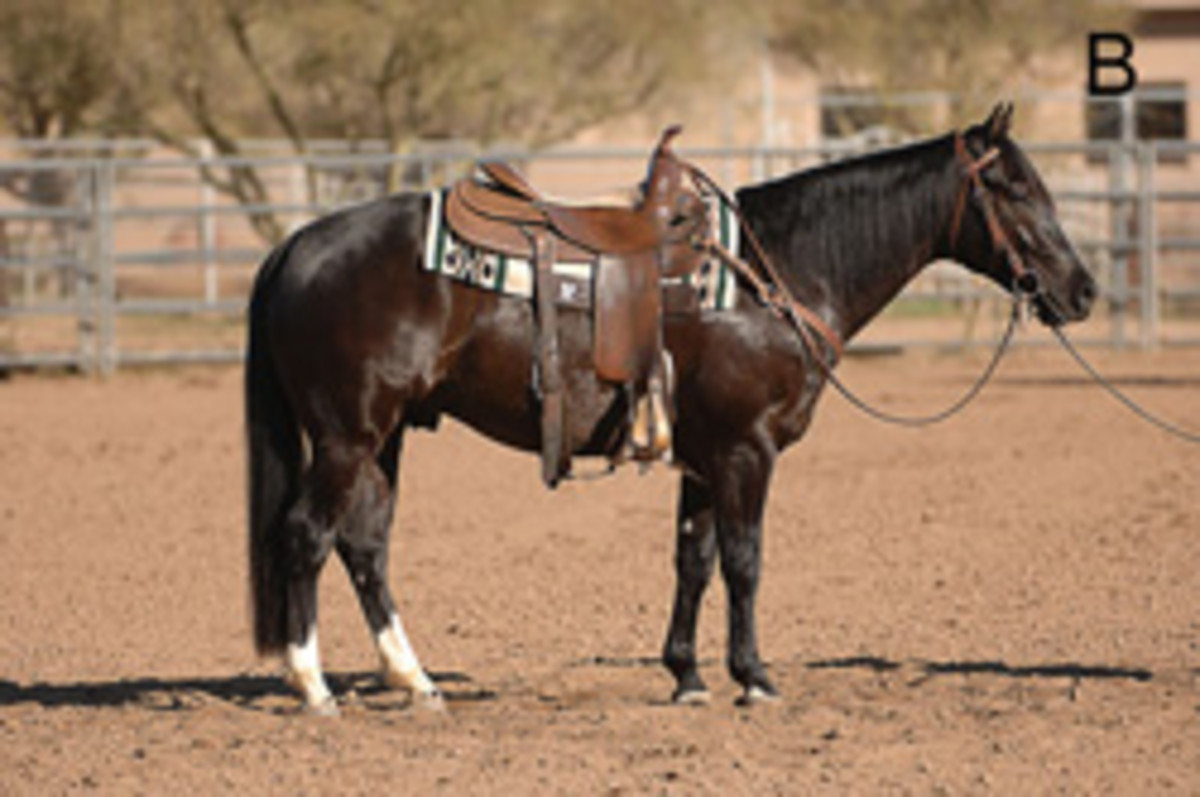
While Horse B’s hindquarter conformation is adequate, with enough muscling for driving power and
strength, he lacks the other horse’s degree of stifle muscling, and isn’t as plumb as Horse A in the column of his hind-leg bones. Note how his hocks sit out farther behind his hips than Horse A’s hocks do. This trait makes it harder for him than for Horse A to get into the ground and slide when he’s asked to stop.
Third Matter: Ability
With any horse, proof of potential lies in his actual ability to perform the work he’s asked to do. That in mind, take a look at both horses as they work through a typical day’s training ride. Here’s where you’ll get a good idea of how conformation affects performance. I’m the rider on Horse A, and Horse B’s rider is my assistant trainer, Brad Barkemeyer.
First, compare the two horses as they lope circles. Giving readily to bit contact, Horse A is relaxed and moving freely beneath the weight of his rider. That hindquarter conformation I talked about, including well-muscled stifles and correcty aligned columns of rearleg bones, makes it possible for him to stride up deeply behind and push off. I don’t have to work and struggle to collect him, and he delivers a smooth ride.
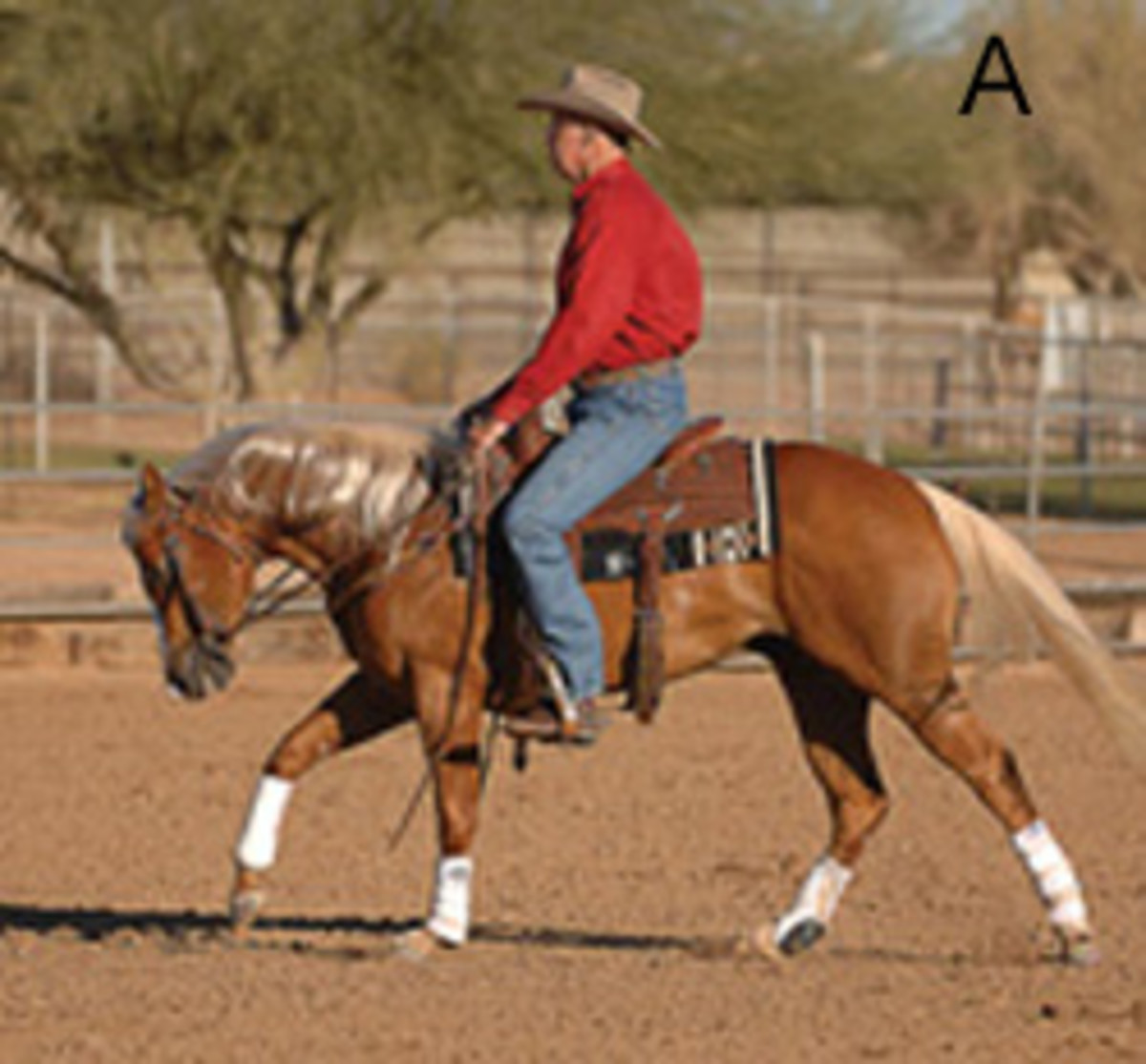

Horse B doesn’t lope as well. His heavier front-end conformation makes it harder for him to lift his shoulders as he moves, and as a result, he’s heavy on his forehand. He doesn’t have nearly the degree of poll flexion that Horse A has, and thus doesn’t bridle up as well. Note the difference in how he carries his neck, and how he appears to be pulling on Brad’s hands.
Next, keeping in mind that both horses were just learning to stop when these photos were taken, compare their ability at this reining maneuver. Horse A is light on the reins, with good body balance and a rounded back, as he gets his butt in the ground. He doesn’t appear to be straining, stiffening, or otherwise struggling to get stopped. With this much natural ability apparent early in his training, he encourages me to go on with him.
Not so with Horse B, whose photo reveals that stopping’s not as easy for him at this stage of his training. To get himself stopped, he has to stiffen his front end, which leads to an almost-hollowed, flattened back, and he has no poll flexion at all. He can’t get his hind legs well up underneath him, so his stop has little slide
to it. While additional training would improve his fitness, which in turn might make stopping somewhat easier for him, nothing will change the conformation traits that keep his stopping ability from being on par with that of Horse A.
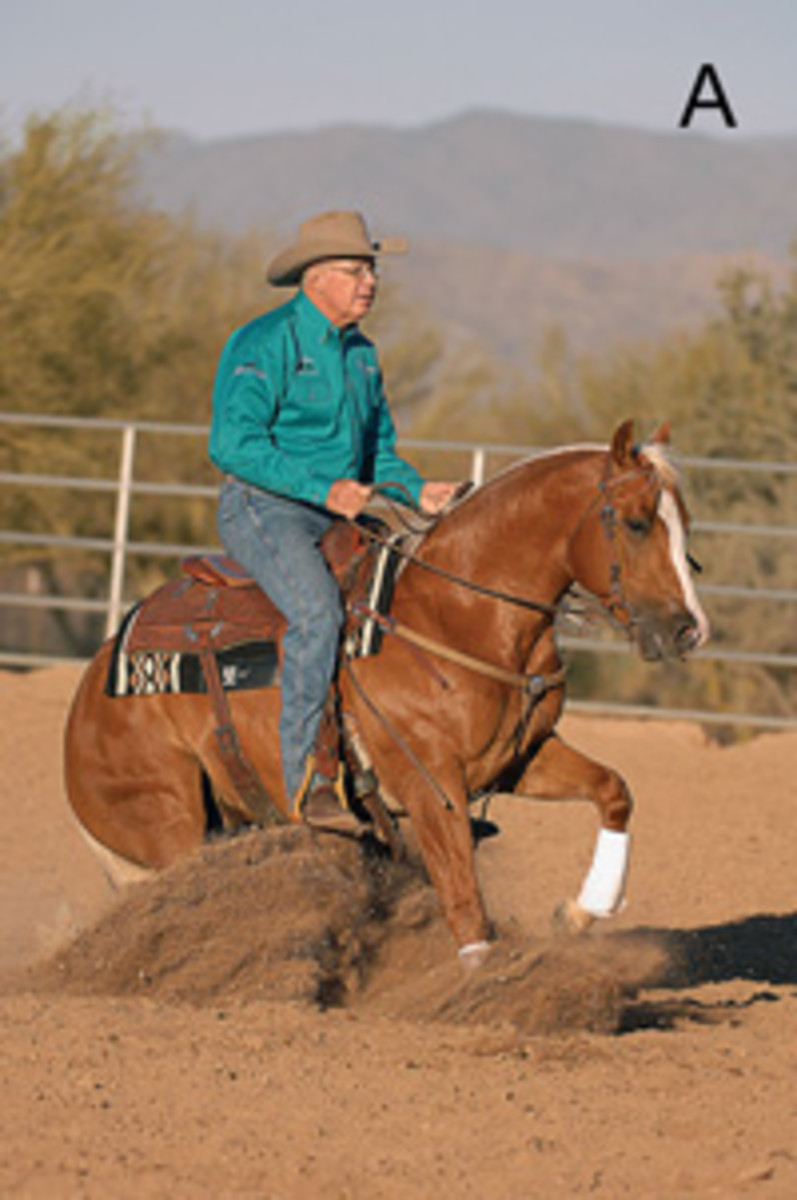
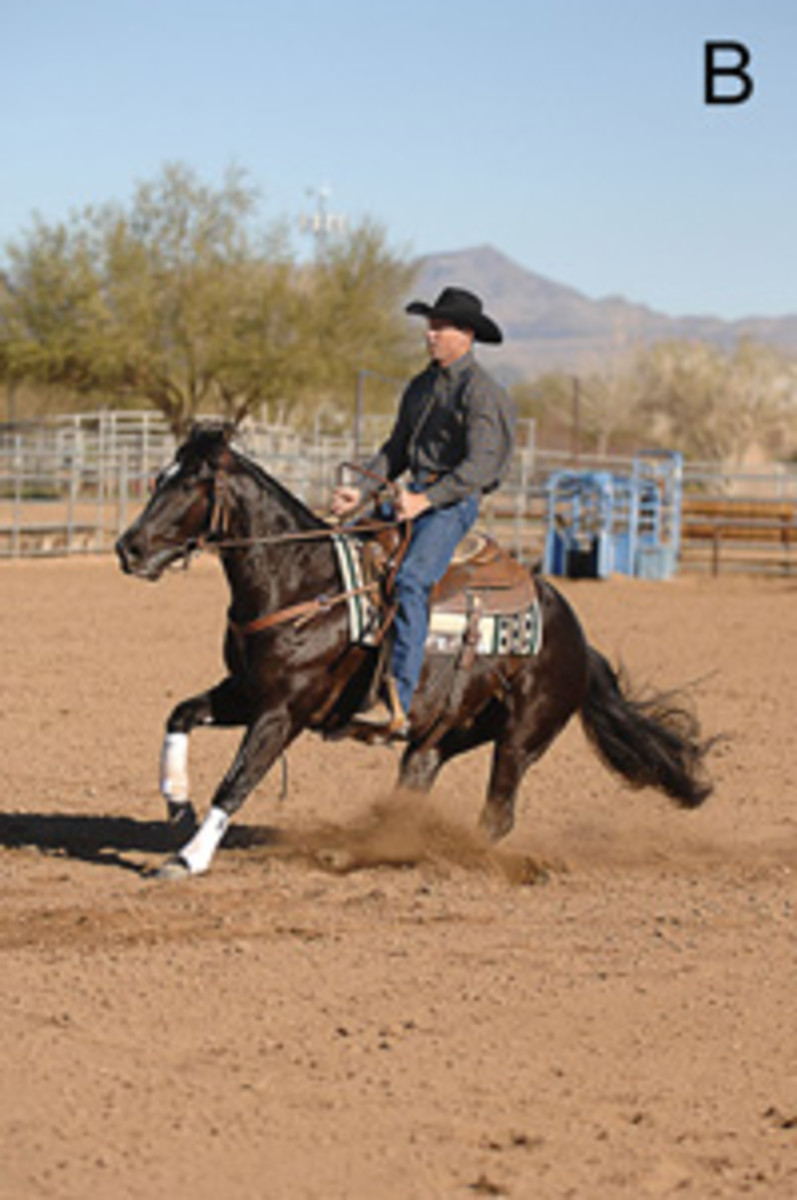
Space limitations prevent me from being able to show you comparative photos of all the other maneuvers Horse A and Horse B have learned. Nevertheless, I can tell you flat out that Horse A is better at all of them.
Fourth Matter: Heart
While pedigree and conformation analysis can tell you quite a lot about a horse’s potential as a reiner, there’s one key matter you can’t determine until you actually start riding and training him. That’s the matter of heart, or “try.” Horses vary greatly when it comes to this, as it’s an individual thing. Some have little to none of this quality, and others have a seemingly bottomless supply. The closer a horse is to the bottomless side of the spectrum, the better the performer he’ll turn out to be–in reining, or any other discipline.
Often, a horse with a lot of heart is able to compensate, at least to some degree, for less-than-ideal reining conformation. He’ll put up with the repetition and physical exertion that reining maneuvers require, and won’t rebel or quit you when training hits a difficult period. He’ll try to find a way to please you, and even if his best isn’t as good as that of another horse, he’ll deliver it with consistency.
This is one reason why horse training is as much an art and a mystery as it is a science. It’s also why the more prospects you try, the more readily you’ll know heart in a horse when he has it–and why a horse that’s big on heart, and maybe not so big on reining ability, still has a purpose in this world.
This article originally appeared in the December 2007 issue of Horse & Rider magazine.






